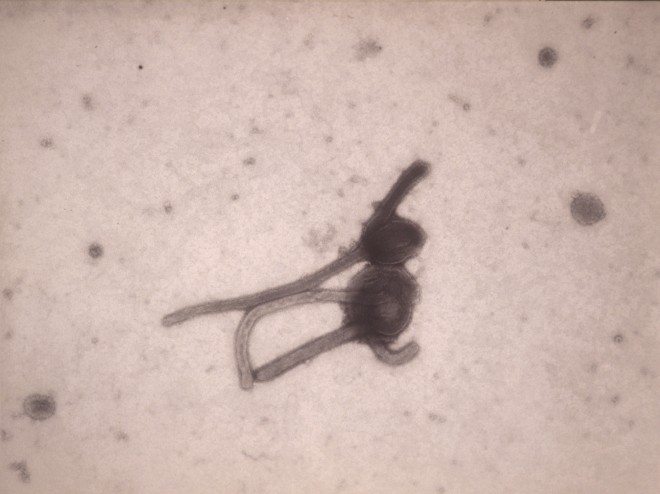
This undated photo made available by the Antwerp Institute of Tropical Medicine in Antwerp, Belgium, shows the Ebola virus viewed through an electron microscope. AP
CLARK FREEPORT—Like the 2003 campaign against the severe acute respiratory syndrome (SARS), local governments are being mobilized as the first line of defense in preventing the entry and spread of Ebola in the Philippines, a Department of Health (DOH) official said here on Friday.
Local governments are numerous and their reach is far and wide, making them a big help in the Ebola preventive campaign, Dr. Lyndon Lee Suy, DOH spokesperson, said at a news briefing on emerging infectious diseases.
There are 81 provincial governments, 143 city governments, 1,494 municipal governments and 42,026 barangay governments spread around the country.
The national government has devolved basic health services to the local governments after the enactment of the Local Government Code of 1991.
‘Tough task’
Lee Suy said local governments should step forward to help because preventing the entry of Ebola, which has claimed the lives of nearly 1,000 people in West Africa, was a “tough task.”
He said the Philippines could be exposed to the virus in two ways: through the 3,000 to 5,000 Filipino migrant workers in Liberia, Sierra Leone and Guinea and through Filipino peacekeeping troops working for the United Nations in Liberia.
The Department of Foreign Affairs has restricted travel by Filipinos to the affected West African countries, Lee Suy said.
He said Nigeria, while not yet a country of concern, began to have suspected Ebola cases this week.
There are a number of Filipinos working in Nigeria and Nigerians come to the Philippines for study or work, he said.
Only 2 still under surveillance
Lee Suy said three Filipino migrant workers—two had fever and another had a bad cough—turned out to be negative of the Ebola virus.
They belonged to a group of eight migrant workers who returned home from the three African countries, he said.
Seven more migrant workers are being monitored, he said. (The DOH in Manila said on Friday that only two migrant workers remained under surveillance.)
Lee Suy gave assurance that the Philippines remains free of Ebola and the Middle East respiratory syndrome (MERS).
Ebola watch
He said the DOH, several national agencies, including airports, were running the surveillance for Ebola.
“What we wanted is to make sure that Ebola doesn’t make it to the Philippines. Globally, the problem is there. We are at a stage of preventing the entry, which is a tough task. It may not be feasible but we’re working to contain it,” he said.
While the Bureau of Immigration can intercept people showing signs and symptoms of Ebola like fever through thermal scanners at airports, the DOH cannot hold or isolate them unless they agree to cooperate, Lee Suy said.
It is best to limit the movement of suspected Ebola patients and local governments can help by recommending hospitals where the patients can be isolated and get medical help, he said.
The Research Institute for Tropical Medicine in Quezon City can verify whether they are Ebola cases, he added.
Bats monitored
Lee Suy said local governments should dedicate health personnel to handle suspected Ebola cases.
He said communities could also help by reporting neighbors who had come home from Ebola-affected countries.
Lee Suy also said the Ebola Reston virus monitored in pigs in a farm in Bulacan province in 2009 was different from the Ebola virus in humans.
Bats are also being monitored as carriers of the virus, he said.
During the outbreak of SARS, the Catholic Church stopped congregants from holding hands while singing the Lord’s Prayer, but Lee Suy said stopping migrant workers from kissing or holding their partners would “create fear and stigmatize” them.
He said the DOH’s 2015 budget included P65 million for preventing and dealing with emerging infectious diseases.
RELATED STORIES
DOH: 5 OFWs cleared of Ebola virus
World takes precautions vs deadly Ebola outbreak
Alert up against animals from Africa amid Ebola outbreak